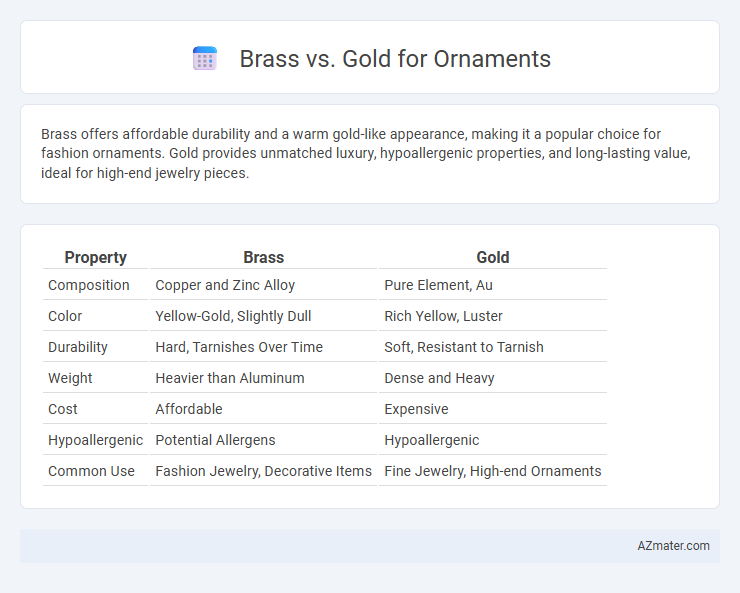Brass offers affordable durability and a warm gold-like appearance, making it a popular choice for fashion ornaments. Gold provides unmatched luxury, hypoallergenic properties, and long-lasting value, ideal for high-end jewelry pieces.
Table of Comparison
| Property | Brass | Gold |
|---|---|---|
| Composition | Copper and Zinc Alloy | Pure Element, Au |
| Color | Yellow-Gold, Slightly Dull | Rich Yellow, Luster |
| Durability | Hard, Tarnishes Over Time | Soft, Resistant to Tarnish |
| Weight | Heavier than Aluminum | Dense and Heavy |
| Cost | Affordable | Expensive |
| Hypoallergenic | Potential Allergens | Hypoallergenic |
| Common Use | Fashion Jewelry, Decorative Items | Fine Jewelry, High-end Ornaments |
Introduction to Brass and Gold in Ornamentation
Brass, an alloy of copper and zinc, is valued in ornamentation for its durability, affordability, and warm golden hue that resembles gold, making it a popular choice for costume jewelry and decorative accessories. Gold, a precious metal known for its luster, malleability, and resistance to tarnish, has been a symbol of luxury, status, and wealth in ornamentation for centuries, often used in fine jewelry and intricate designs. Both materials offer distinct advantages in ornamentation, with brass providing an economical alternative and gold offering timeless elegance and intrinsic value.
Historical Uses of Brass and Gold in Jewelry
Brass has been historically valued in jewelry for its affordability and resemblance to gold, prominently used in ancient Egyptian and Roman adornments to create bold, durable designs. Gold, revered for its rarity, malleability, and resistance to tarnish, has symbolized wealth and status across civilizations from Mesopotamia to the Renaissance, often fashioned into intricate, regal pieces. The contrasting properties of brass and gold shaped their use in jewelry, with brass serving as an accessible alternative and gold reserved for prestigious, ceremonial artifacts.
Physical Properties: Brass vs Gold
Brass is an alloy composed primarily of copper and zinc, exhibiting high durability, corrosion resistance, and a characteristic yellow-gold color, while being markedly harder and less dense than pure gold. Gold is a dense, malleable, and highly ductile metal with excellent resistance to tarnish and corrosion, valued for its rich luster and hypoallergenic properties. Compared to brass, gold offers superior softness allowing intricate designs, but lacks the mechanical strength and affordability that brass provides in ornamental applications.
Appearance and Aesthetic Differences
Brass ornaments exhibit a warm, golden-yellow hue with a slightly muted, vintage appeal due to their copper-zinc alloy composition, often developing a rich patina over time. Gold ornaments offer a luxurious, vibrant shine with a consistent yellow color that resists tarnishing, enhancing elegance and timeless beauty. The aesthetic difference lies in brass's rustic charm and antique look compared to gold's polished brilliance and premium status.
Durability and Longevity Comparison
Brass offers notable durability due to its resistance to corrosion and wear, making it suitable for everyday ornaments that require long-lasting strength. Gold, especially in higher karats, provides excellent resistance to tarnish and maintains its luster over time, contributing to superior longevity in fine jewelry. While gold outperforms brass in terms of lasting value and aesthetic preservation, brass remains a cost-effective alternative with considerable durability for decorative purposes.
Cost Comparison: Brass vs Gold Ornaments
Brass ornaments offer a highly affordable alternative to gold, often costing a fraction of gold's price per gram, making them accessible for budget-conscious buyers. Gold ornaments, however, maintain intrinsic value and resale potential, with prices influenced by karat quality and market fluctuations. The cost difference significantly impacts purchasing decisions, where brass provides decorative appeal without the investment value of gold.
Maintenance and Care for Brass and Gold Ornaments
Brass ornaments require regular cleaning with a mixture of mild soap and warm water to prevent tarnishing, and periodic polishing with a brass cleaner helps maintain their shine. Gold ornaments are more resistant to tarnish but should be gently cleaned with a soft cloth and mild jewelry cleaner to preserve their luster and avoid scratching. Both metals benefit from proper storage in a dry place away from direct sunlight to minimize deterioration and maintain their aesthetic appeal.
Allergies and Skin Sensitivity Concerns
Brass jewelry often contains copper and zinc, which can cause allergic reactions or skin irritation in sensitive individuals due to metal ion release. Gold, especially high-karat varieties such as 18K or 24K, is hypoallergenic and less likely to trigger skin sensitivities, making it a safer choice for people prone to allergies. Choosing gold over brass reduces the risk of contact dermatitis and other allergic reactions associated with prolonged skin contact.
Environmental Impact of Brass vs Gold Production
Brass production involves the combination of copper and zinc, metals that require significant mining but generally have lower environmental impacts compared to gold extraction, which is highly energy-intensive and often involves toxic chemicals like cyanide. Gold mining generates extensive habitat destruction, substantial water pollution, and higher carbon emissions due to complex extraction and refining processes. Choosing brass for ornaments can reduce ecological footprints by minimizing resource depletion and pollution associated with precious metal mining.
Choosing the Right Metal for Your Ornaments
Brass offers a durable and affordable alternative to gold, featuring a warm golden hue that complements various jewelry designs while resisting tarnish and corrosion. Gold, prized for its natural luster, hypoallergenic properties, and status as a precious metal, provides unmatched value and longevity in ornaments. Selecting the right metal depends on budget, maintenance preference, and desired aesthetics, with brass suitable for everyday wear and gold ideal for investment-grade, heirloom-quality pieces.

Infographic: Brass vs Gold for Ornament
 azmater.com
azmater.com